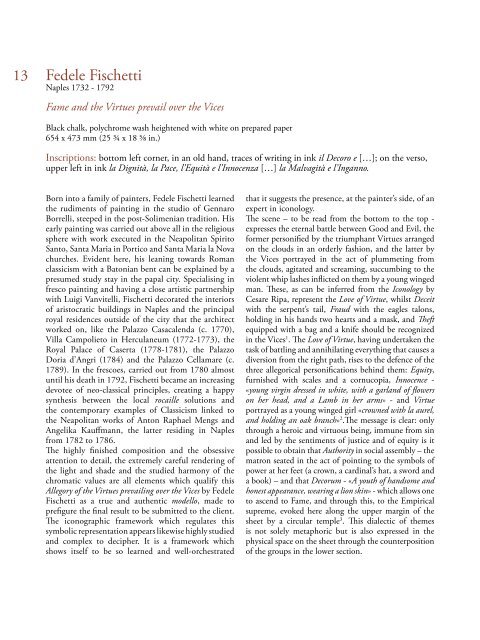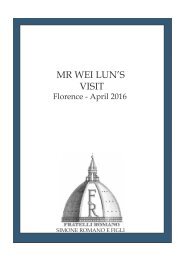A selection of master drawings 2016
- No tags were found...
Create successful ePaper yourself
Turn your PDF publications into a flip-book with our unique Google optimized e-Paper software.
13<br />
Fedele Fischetti<br />
Naples 1732 - 1792<br />
Fame and the Virtues prevail over the Vices<br />
Black chalk, polychrome wash heightened with white on prepared paper<br />
654 x 473 mm (25 ¾ x 18 ⅝ in.)<br />
Inscriptions: bottom left corner, in an old hand, traces <strong>of</strong> writing in ink il Decoro e […]; on the verso,<br />
upper left in ink la Dignità, la Pace, l’Equità e l’Innocenza […] la Malvagità e l’Inganno.<br />
Born into a family <strong>of</strong> painters, Fedele Fischetti learned<br />
the rudiments <strong>of</strong> painting in the studio <strong>of</strong> Gennaro<br />
Borrelli, steeped in the post-Solimenian tradition. His<br />
early painting was carried out above all in the religious<br />
sphere with work executed in the Neapolitan Spirito<br />
Santo, Santa Maria in Portico and Santa Maria la Nova<br />
churches. Evident here, his leaning towards Roman<br />
classicism with a Batonian bent can be explained by a<br />
presumed study stay in the papal city. Specialising in<br />
fresco painting and having a close artistic partnership<br />
with Luigi Vanvitelli, Fischetti decorated the interiors<br />
<strong>of</strong> aristocratic buildings in Naples and the principal<br />
royal residences outside <strong>of</strong> the city that the architect<br />
worked on, like the Palazzo Casacalenda (c. 1770),<br />
Villa Campolieto in Herculaneum (1772-1773), the<br />
Royal Palace <strong>of</strong> Caserta (1778-1781), the Palazzo<br />
Doria d’Angri (1784) and the Palazzo Cellamare (c.<br />
1789). In the frescoes, carried out from 1780 almost<br />
until his death in 1792, Fischetti became an increasing<br />
devotee <strong>of</strong> neo-classical principles, creating a happy<br />
synthesis between the local rocaille solutions and<br />
the contemporary examples <strong>of</strong> Classicism linked to<br />
the Neapolitan works <strong>of</strong> Anton Raphael Mengs and<br />
Angelika Kauffmann, the latter residing in Naples<br />
from 1782 to 1786.<br />
The highly finished composition and the obsessive<br />
attention to detail, the extremely careful rendering <strong>of</strong><br />
the light and shade and the studied harmony <strong>of</strong> the<br />
chromatic values are all elements which qualify this<br />
Allegory <strong>of</strong> the Virtues prevailing over the Vices by Fedele<br />
Fischetti as a true and authentic modello, made to<br />
prefigure the final result to be submitted to the client.<br />
The iconographic framework which regulates this<br />
symbolic representation appears likewise highly studied<br />
and complex to decipher. It is a framework which<br />
shows itself to be so learned and well-orchestrated<br />
that it suggests the presence, at the painter’s side, <strong>of</strong> an<br />
expert in iconology.<br />
The scene – to be read from the bottom to the top -<br />
expresses the eternal battle between Good and Evil, the<br />
former personified by the triumphant Virtues arranged<br />
on the clouds in an orderly fashion, and the latter by<br />
the Vices portrayed in the act <strong>of</strong> plummeting from<br />
the clouds, agitated and screaming, succumbing to the<br />
violent whip lashes inflicted on them by a young winged<br />
man. These, as can be inferred from the Iconology by<br />
Cesare Ripa, represent the Love <strong>of</strong> Virtue, whilst Deceit<br />
with the serpent’s tail, Fraud with the eagles talons,<br />
holding in his hands two hearts and a mask, and Theft<br />
equipped with a bag and a knife should be recognized<br />
in the Vices 1 . The Love <strong>of</strong> Virtue, having undertaken the<br />
task <strong>of</strong> battling and annihilating everything that causes a<br />
diversion from the right path, rises to the defence <strong>of</strong> the<br />
three allegorical personifications behind them: Equity,<br />
furnished with scales and a cornucopia, Innocence -<br />
«young virgin dressed in white, with a garland <strong>of</strong> flowers<br />
on her head, and a Lamb in her arms» - and Virtue<br />
portrayed as a young winged girl «crowned with la aurel,<br />
and holding an oak branch» 2 .The message is clear: only<br />
through a heroic and virtuous being, immune from sin<br />
and led by the sentiments <strong>of</strong> justice and <strong>of</strong> equity is it<br />
possible to obtain that Authority in social assembly – the<br />
matron seated in the act <strong>of</strong> pointing to the symbols <strong>of</strong><br />
power at her feet (a crown, a cardinal’s hat, a sword and<br />
a book) – and that Decorum - «A youth <strong>of</strong> handsome and<br />
honest appearance, wearing a lion skin» - which allows one<br />
to ascend to Fame, and through this, to the Empirical<br />
supreme, evoked here along the upper margin <strong>of</strong> the<br />
sheet by a circular temple 3 . This dialectic <strong>of</strong> themes<br />
is not solely metaphoric but is also expressed in the<br />
physical space on the sheet through the counterposition<br />
<strong>of</strong> the groups in the lower section.





